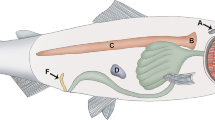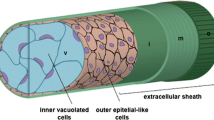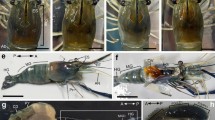Abstract
Bronze corydoras (Corydoras aeneus) is a small diurnal activity fish from South America. Under hypoxia conditions, it uses the posterior part of the intestine as an accessory respiratory organ. The present PCR studies demonstrated higher expression of HIF-1α (hypoxia-inducible factor) gene in the respiratory than that in digestive part of bronze corydoras intestine. Further, immunolocalization studies using antibodies specific to HIF-1α and transmission electron microscopy (TEM) revealed the presence of HIF-1α epitopes in the intestine of Corydoras aeneus. In the respiratory intestine, the numerous clusters of gold particles visualizing HIF-1α antibody were observed within fibroblasts, whereas in the digestive tract of this species, single gold grains in the epithelial cells were noted. On the other hand, the presence of HIF-1α and the cytoplasmic domain of the epidermal growth factor receptor (EGFR) in the respiratory intestine of bronze corydoras assumes their interactions in the system where these factors appeared for the first time. The non-obligatory air-breathing fishes using their digestive tract as an accessory respiratory organ during hypoxia conditions are very interesting for the studies of the processes that control HIF-1α expression and squamous cell proliferation.



Similar content being viewed by others
References
Carter GS, Beadle LC (1931) The fauna of the swamps of the Paraguayan Chaco in relation to its environment II respiratory adaptations in the fishes. J Limnol Soc (Zool) 37:327–368
Da Cruz AL, Fernandes MN (2016) What is the most efficient respiratory organ for the loricariid air-breathing fish Pterygoplichthys anisitsi, gills or stomach? A quantitative morphological study. Zoology (Jena) 119(6):526–533
Gracey AY, Troll JV, Somero GN (2001) Hypoxia-induced gene expression profiling in the euryoxic fish Gillichthys mirabilis. Proc Natl Acad Sci U S A 98(4):1993–1998
Graham JB (1997) Air-breathing fishes. Evolution, diversity and adaptation. Academic Press, San Diego
Jonz MG, Buck LT, Perry SF, Schwerte T, Zaccone G (2016) Sensing and surviving hypoxia in vertebrates. Ann N Y Acad Sci 1365(1):43–58
Kramer DL, McClure M (1980) Aerial respiration in the catfish, Corydoras aeneus (Callichthyidae). Can J Zool 58(11):1984–1991
Kwasek K, Rimoldi S, Cattaneo AG, Parker T, Dabrowski K, Terova G (2017) The expression of hypoxia-inducible factor-1α gene is not affected by low-oxygen conditions in yellow perch (Perca flavescens) juveniles. Fish Physiol Biochem 43(3):849–862
Lauriano ER, Icardo JM, Zaccone G, Kuciel M, Satora L, Alesci A, Alfa M, Zaccone D (2015) Expression patterns and quantitative assessment of neurochemical markers in the lung of the gray bichir, Polypterus senegalus (Cuvier, 1829). Acta Histochem 117(8):738–746
Liu S, Zhu K, Chen N, Wang W, Wang H (2013) Identification of HIF-1α promoter and expression regulation of HIF-1α gene by LPS and hypoxia in zebrafish. Fish Physiol Biochem 39(5):1153–1163
Lu H, Liang K, Lu Y, Fan Z (2012) The anti-EGFR antibody cetuximab sensitizes human head and neck squamous cell carcinoma cells to radiation in part through inhibiting radiation-induced upregulation of HIF-1α. Cancer Lett 322(1):78–85
Majmundar AJ, Wong WJ, Simon MC (2010) Hypoxia-inducible factors and the response to hypoxic stress. Mol Cell 40(2):294–309
Masound GN, Li W (2015) HIF-1α pathway: role, regulation and intervention for cancer therapy. Acta Pharm Sin B 5(5):378–389
Mytych J, Satora L, Kozioł K (2018) Confirmation of the immunoreactivity of monoclonal anti-human C-terminal EGFR antibodies in bronze Corydoras Corydoras aeneus (Callichthyidae Teleostei) by Western blot method. Acta Histochem 120(2):151–153
Nelson JA (2014) Breaking wind to survive: fishes that breathe air with their gut. J Fish Biol 84(3):554–576
Nikinmaa M, Rees BB (2005) Oxygen-dependent gene expression in fishes. Am J Phys Regul Integr Comp Phys 288:R1079–R1090
Okuda KS, Lee HM, Velaithan V, Ng MF, Patel V (2016) Utilizing zebrafish to identify anti- (lymph) angiogenic compounds for cancer treatment: promise and future challenges. Review. Microcirculation 23(6):389–405
Peyton C, Thomas P (2011) Involvement of epidermal growth factor receptor signaling in estrogen inhibition of oocyte maturation mediated through the G protein-coupled estrogen receptor (Gper) in Zebrafish (Danio rerio). Biol Reprod 85(1):42–50
Podkowa D, Goniakowska-Witalińska L (2002) Adaptations to the air-breathing in the posterior intestine of the catfish (Corydoras aeneus, Callichthyidae). A histological and ultrastructural study. Folia Biol (Kraków) 50(1–2):69–82
Rahman MS, Thomas P (2007) Molecular cloning, characterization and expression of two hypoxia-inducible factor alpha subunits, HIF-1alpha and HIF-2alpha, in a hypoxia-tolerant marine teleost, Atlantic croaker (Micropogonias undulatus). Gene 396(2):273–282
Randall DJ, Burggren WW, Farrell AP, Haswell MS (1981) The evolution of air breathing in vertebrates. Cambridge University Press, London, pp 1–36
Rimoldi S, Terova G, Zaccone G, Parker T, Kuciel M, Dabrowski K (2016) The effect of hypoxia and hyperoxia on growth and expression of hypoxia-related genes and proteins in spotted gar Lepisosteus oculatus larvae and juveniles. J Exp Zool B Mol Dev Evol 326(4):250–267
Rissanen E, Tranberg HK, Nikinmaa M (2006) Oxygen availability regulates metabolism and gene expression in trout hepatocyte cultures. Am J Phys Regul Integr Comp Phys 291(5):R1507–R1515
Satora L (1998) Histological and ultrastructural study of the stomach of the air-breathing Ancistrus multispinnis (Siluriformes, Teleostei). Can J Zool 76(1):83–86
Satora L, Kozioł K, Zebrowski J (2017) Squamous epithelium formation in the respiratory intestine of the bronze Corydoras Corydoras aeneus (Callichthyidae Teleostei). Acta Histochem 119(5):563–568
Schartl M, Walter RB (2016) Xiphophorus and medaka cancer models. Adv Exp Med Biol 916:531–552
Soitamo AJ, Rabergh CM, Gassmann M, Sistonen L, Nikinmaa M (2001) Characterization of a hypoxia-inducible factor (HIF-1alpha ) from rainbow trout. Accumulation of protein occurs at normal venous oxygen tension. J Biol Chem 276(23):19699–19705
Terova G, Rimoldi S, Corà S, Bernardini G, Gornati R, Saroglia M (2008) Acute and chronic hypoxia affects HIF-1α mRNA levels in sea bass (Dicentrarchus labrax). Aquaculture 279(1–4):150–159
Zaccone G, Lauriano ER, Kuciel M, Capillo G, Pergolizzi S, Alesci A, Ishimatsu A, Ip YK, and Icardo JM (2017) Identification and distribution of neuronal nitric oxide synthase and neurochemical markers in the neuroepithelial cells of the gill and the skin in the giant mudskipper, Periophthalmodon schloss. Zoology (Jena) 125:31–52
Zagórska A, Dulak J (2004) HIF-1: the knowns and unknowns of hypoxia sensing. Acta Biochim Pol 51(3):563–585
Acknowledgments
The authors wish to thank Prof. Janusz Karasiński from the Institute of Zoology (Jagiellonian University) for all helpful suggestions in the analysis of TEM images. TEM observations were performed with the kind assistance of Szymon Suski at the Laboratory of Electron Microscopy, Nencki Institute of Experimental Biology, PAS, Warsaw, Poland. The authors wish to thank anonymous Reviewers for suggestions that have improved the manuscript significantly.
Author information
Authors and Affiliations
Contributions
L.S. conceived and designed the research project and wrote the manuscript. A.B-K. performed and analyzed the immunohistochemical reaction and wrote sections concerning the microscopic study. J.M. performed and analyzed the PCR reactions and wrote sections concerning this method.
Corresponding author
Ethics declarations
Competing interests
The authors declare that they have no competing interests.
Rights and permissions
About this article
Cite this article
Satora, L., Mytych, J. & Bilska-Kos, A. The presence and expression of the HIF-1α in the respiratory intestine of the bronze Corydoras Corydoras aeneus (Callichthyidae Teleostei). Fish Physiol Biochem 44, 1291–1297 (2018). https://doi.org/10.1007/s10695-018-0520-2
Received:
Accepted:
Published:
Issue Date:
DOI: https://doi.org/10.1007/s10695-018-0520-2




